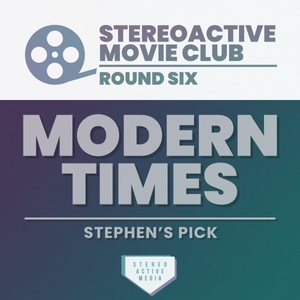
Stereoactive Movie Club
Stereoactive Media

1 Creator

1 Creator
Alicia, Mia, Stephen, and Jeremiah – along with special guests – are discussing some of the greatest movies ever made. Who says? Sight And Sound magazine says. Every ten years, since 1952, the publication has surveyed critics and directors to determine which films, according to those surveyed, might be considered the best. The five film-loving friends take turns picking movies that have appeared on the list and then dig into them with an eye on their cultural impact, how they stand up today, and just whether they’re actually as good as all those critics and directors say they are.


2 Listeners
1 Comment
All episodes
Best episodes
Seasons
Top 10 Stereoactive Movie Club Episodes
Goodpods has curated a list of the 10 best Stereoactive Movie Club episodes, ranked by the number of listens and likes each episode have garnered from our listeners. If you are listening to Stereoactive Movie Club for the first time, there's no better place to start than with one of these standout episodes. If you are a fan of the show, vote for your favorite Stereoactive Movie Club episode by adding your comments to the episode page.

Ep 6.3 // Modern Times
Stereoactive Movie Club
08/15/23 • 68 min
It’s Stephen’s Round 6 Pick: Modern Times, the 1936 film starring, written, and directed by Charlie Chaplin.
Modern Times marked at least the 60th appearance of Charlie Chaplin in a film as the Little Tramp – and depending on whether you think the barber character in The Great Dictator is also the Tramp, Modern Times may be the last time Chaplin played the character. And while his previous film, 1931’s City Lights, featured synchronized music and sound effects, Modern Times was the first time Chaplin employed synchronized dialogue, though obviously minimal. At first, Modern Times was conceived of as a potentially full-on talkie, but eventually Chaplin decided that his famous character worked better in the silent format, so the film mainly adheres to that style, other than the final moments of the film, with the previously mentioned sung gibberish
Reviews at the time were positive and the film was a financial success despite its anomalous nature 9 years after the debut of The Jazz Singer – which is a testament to the long popularity of Chaplin and his character up to that point. In 1998 it was ranked #81 on AFI’s 100 Years... 100 Movies list – and it rose a few spots to #78 when they redid the list in 2007. It also ranked #33 on AFI’s 100 Years... 100 Laughs list in 2000.
As for our purposes, Modern Times has never been in the top 10 of Sight and Sound’s polling of critics, but it was ranked #6 in the very first polling of directors in 1992. In the 2022 polling, it was tied at #78 in the critics polling and tied at #72 by directors – and among the filmmakers who had it on their top 10 lists in 2022 was documentarian Frederick Wiseman.
Produced by Stereoactive Media


2 Listeners

Stereoactive Movie Club Trailer
Stereoactive Movie Club
03/07/24 • 0 min
The Stereoactive Movie Club is discussing some of the greatest movies ever made. Who says? Sight and Sound magazine says. Every ten years, since 1952, Sight and Sound has surveyed critics and directors to determine which films, according to those surveyed, might be considered the best. The five film-loving friends take turns picking movies that have appeared on the list and then dig into them with an eye on their cultural impact, how they stand up today, and just whether they’re actually as good as all those critics and directors say they are.
Listen at stereoactivemovieclub.com or anywhere you get your podcasts.
And follow/subscribe to Stereoactive Media.

1 Listener

Ep 5.6 // Apocalypse Now
Stereoactive Movie Club
04/18/23 • 86 min
It’s Alicia’s 5th pick: Apocalypse Now, the 1979 film directed by Francis Ford Coppola.
Coppola’s fellow New Hollywood/Movie Brat filmmaker, John Milius first conceived of adapting ‘Heart of Darkness’ as a Vietnam War movie sometime in the late ‘60s. The original plan was for Milius to write, Coppola to produce, and for George Lucas to direct. Eventually, as Lucas became busy with other projects, Coppola became the project’s director and co-writer.
The film’s shooting schedule in the Philippines was originally set for 5 months, but ended up taking more like 14 months. A lot of the reasons why are pretty well documented in the 1991 documentary spearheaded and co-directed by Eleanor Coppola, Francis’ wife – it’s called Hearts of Darkness: A Filmmaker's Apocalypse and is totally worth checking out.
Reviews at the time were mixed, with some crowning it a high achievement from the start while others praised the impressive craft of the filmmaking, but found the storytelling wanting. Despite its mixed critical reception, it made good money at the box office and ended up winning the Palme d'Or at Cannes. It also won two Academy Awards for Best Cinematography and Best Sound, and was nominated for another 6: Best Picture; Best Director; Best Actor in a Supporting Role, Robert Duvall; Best Adapted Screenplay; Best Art Direction; Best Film Editing.
The big winner at the Oscars that year, though, was Kramer vs. Kramer.
As for our purposes, Apocalypse Now has only been in the top 10 of one of Sight And Sound’s polls once, when the directors list had it at number 6 in 2012. In the new 2022 polling, it was ranked #19 by critics and #18 by directors.
Produced by Stereoactive Media

1 Listener

Ep 6.4 // Wild Strawberries
Stereoactive Movie Club
09/12/23 • 81 min
It’s Alicia’s Round 6 Pick: Wild Strawberries, the 1957 film written and directed by Ingmar Bergman.
Wild Strawberries was Ingmar Bergman’s 18th feature film in eleven years. It was written while he was in a hospital for stress and gastric issues, then quickly produced as his personal life was in disarray.
Critics in Sweden pretty much loved the film, while its reception in the United States was more mixed. But its influence has been strong over the years and directors such as Stanley Kubrick and Andrei Tarkovsky have listed it among their favorite films.
The film was honored at various international film festivals and awards ceremonies, including the Oscars, where, after opening in the US in 1959, it was nominated for Best Original Screenplay... though Bergman refused the nomination in a letter where he called the Oscars a “humiliating institution” for the art of motion pictures. The Doris Day/Rock Hudson romantic comedy Pillow Talk is what eventually won Best Original Screenplay that year, while the big overall winner of the year was Ben-Hur. But to give a sense of what was popular in the United States when Wild Strawberries was released in Sweden a couple of years earlier... The Bridge on the River Kwai was the big Oscar winner for films released in 1957 – and it was also the top-grossing film of the year in North America.
As for our purposes, Wild Strawberries appeared in the top 10 of Sight and Sound’s “greatest films” polling once – when it was ranked #10 in 1972. In the 2022 polling, it was ties at #108 by critics and tied at #72 by directors – and among the filmmakers who had it on their top 10 lists that year was Michael Moore.
Produced by Stereoactive Media

1 Listener

Ep 6.1 // Round 6 Picks!
Stereoactive Movie Club
05/17/23 • 22 min
In our next batch of movies, we'll be traveling from the Soviet Union to Florida with stops in Sweden, Hollywood, and Djibouti along the way...
So, listen up as we reveal our picks for what we’ll be watching in Round 6 of the podcast!
Also, we introduce a special guest who’ll be joining us for all of Round 6!
Produced by Stereoactive Media

1 Listener

Ep 5.7 // Boyhood w/ Max Goransson
Stereoactive Movie Club
05/03/23 • 85 min
It’s Jeremiah’s Round 5 Bonus Pick: Boyhood, the 2014 film directed by Richard Linklater.
Boyhood tells the story of a young boy, his slightly older sister, their divorced parents, and the people who come in and out of their lives over the course of 12 years, from the time the boy is 6 until he’s 18. Step-parents come and go, or even stay. Many moves are made. And we see the ways in which the parents’ decisions and actions affect their kids until they begin to have more agency and independence.
The story is told a year at a time, and, of course, the special thing about it is that it was also filmed a year at a time, so we see every main or recurring character actually age as the film progresses. The effect of the year-by-year production schedule is that each section of the film is something of a time capsule of both the era when it was shot and the time in each cast members’ life, thus lending an air of docu-realism that could never be achieved if it had been filmed more traditionally as something of a period piece. Linklater, cast, and crew would shoot for a few weeks each year, with the script being written as they went to take into account where the actors were in their lives and, to some extent, what was going on in the world and culture from year to year.
The film was budgeted at $200,000 per year of shooting – or $2.4 million total – and ended up earning $57.3 million making it a box office success, especially when considering that it was never in more than 775 theaters in the US. Critical reception was also strong, with many naming it the best, or among the best, films of its year.
Sight And Sound magazine, for the record, polled 112 international contributors and colleagues to decide their top 20 films of 2014 and ranked Boyhood #1.
The film also won the top prize of the year from a number of other critics groups and other organizations. And Patricia Arquette and Ethan Hawke, received much praise for their portrayals of the estranged parents in the film. It was nominated for 6 Academy Awards, but only Patricia Arquette won, for Best Supporting Actress. It’s other nominations were for Best Picture, Best Director, Best Supporting Actor (Ethan Hawke), Best Original Screenplay, and Best Film Editing.
As for our purposes on this podcast, Jeremiah chose this movie as one that he thought deserved to be in the conversation of the Best Films for the 2022 Sight And Sound Poll. It was chosen back before the 2022 poll was out and, as it turns out, it did not make the list. That said, of the ballots that have been made public, director George Miller noticeably had it in his top 10.
Produced by Stereoactive Media

1 Listener

Ep 2.4 // Bicycle Thieves
Stereoactive Movie Club
05/21/21 • 76 min
It’s Lora’s 2nd pick: ‘Bicycle Thieves,’ the 1948 film directed by Vittorio De Sica. It’s an emblematic example of the neorealist movement that developed in Italy after World War II, depicting the lives of everyday people struggling to get by, and mostly cast with non-professional actors. It was voted the #1 greatest film of all time in the very first critics poll Sight & Sound magazine did back in 1952. Since then it’s placed #7 in 1962 and as a runner up in 1992. It was also on the directors poll, at #6 in 2002 and #10 in 2012.
Produced by Stereoactive Media

Ep 2.6 // Mirror
Stereoactive Movie Club
06/14/21 • 79 min
It’s Jeremiah’s 2nd pick: ‘Mirror,’ the 1975 film directed by Andrei Tarkovsky. Nonlinear in structure it features moments from the central character’s life, both as a young boy and as a father, interspersed with bits of newsreel footage, other memories, and poetic passages. It broke into the top 10 of Sight & Sound magazine’s ‘greatest films’ poll in 2012, ranking 9th on the survey of directors.
Produced by Stereoactive Media

Ep 1.2 // The Passion of Joan of Arc
Stereoactive Movie Club
03/01/21 • 72 min
For our first full-fledged movie chat is about Mia’s pick... ‘The Passion of Joan of Arc.’ Directed by Carl Dreyer, the movie depicts the final days of Joan of Arc, as she was held captive by the English and stands trial at the hands of clerics who doubt her claims of being an agent of God. In it, Maria Falconetti, as Joan, depicts a would-be saint struggling to keep her faith in the face of persecution and death. As a film, it's known for its heavy reliance on close-ups, especially those of Falconetti, as you see every raw emotion on her face from moment to moment. Dreyer, a Danish filmmaker, was invited by a French company to make the film – which was itself controversial among many of the French, who believed the story of such a hero of France should be told by a French filmmaker. Almost immediately, after the film was finished, it was compromised through censorship and fire, leaving versions of the film that Dryer was unhappy with as the ones that people mainly saw for years. Even then, though, it was still considered a critical success and even a quick classic.
Produced by Stereoactive Media

Ep 2.3 // The General
Stereoactive Movie Club
05/05/21 • 71 min
It’s Stephen’s 2nd pick: ‘The General,’ the 1926 film directed by Buster Keaton and Clyde Bruckman – and of course also starring Buster Keaton. It’s an action comedy set during the Civil War and largely centered around a stolen train and plenty of stunt work and it’s been on Sight & Sound magazine’s decennial poll of the “greatest films” twice – at #8 in 1972, then at #10 in 1982.
Produced by Stereoactive Media
Show more best episodes

Show more best episodes
Featured in these lists
FAQ
How many episodes does Stereoactive Movie Club have?
Stereoactive Movie Club currently has 40 episodes available.
What topics does Stereoactive Movie Club cover?
The podcast is about Film History, Podcasts, Tv & Film and Film Reviews.
What is the most popular episode on Stereoactive Movie Club?
The episode title 'Ep 6.3 // Modern Times' is the most popular.
What is the average episode length on Stereoactive Movie Club?
The average episode length on Stereoactive Movie Club is 69 minutes.
How often are episodes of Stereoactive Movie Club released?
Episodes of Stereoactive Movie Club are typically released every 15 days.
When was the first episode of Stereoactive Movie Club?
The first episode of Stereoactive Movie Club was released on Feb 6, 2021.
Show more FAQ

Show more FAQ
Comments

@stereoactivemedia
Mar 7
Like
Reply